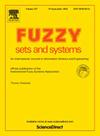Radon-Nikodým theorems for generalized fuzzy number measures
IF 3.2
1区 数学
Q2 COMPUTER SCIENCE, THEORY & METHODS
引用次数: 0
Abstract
In this paper we deal with generalized fuzzy number measures defined on Σ and taking values in the set , where is a complete finite measure space, is the family of all non-empty convex weakly compact subsets of a Banach space X and is such that a fuzzy set is a member of if and only if We show two Radon-Nikodým theorems for such generalized fuzzy number measures in terms of Pettis integral of fuzzy mappings. The first theorem works for a μ-continuous generalized fuzzy number measure of bounded variation in a Banach space X with the Radon-Nikodým property (RNP). The next theorem shows that if a generalized fuzzy number measure is “dominated” by a generalized fuzzy number in terms of α-level sets, i.e., then there exists a fuzzy mapping Pettis integrable with for all , where is Pettis integral of fuzzy mapping Γ over A. The main advantage of our results is the absence of any separability assumptions.
Radon-Nikodým广义模糊数测度定理
本文讨论了在Σ上定义的广义模糊数测度,并在集合Fcwk(X)上取值,其中(Ω,Σ,μ)是一个完全有限测度空间,cwk(X)是Banach空间X的所有非空凸弱紧子集的族,Fcwk(X)使得模糊集u:X→[0,1]是Fcwk(X)的成员,当且仅当对于所有α∈(0,1)([u]α={X∈X:u(X)≥α}),模糊集u∈cwk(X)。我们用模糊映射的Pettis积分给出了这类广义模糊数测度的两个Radon-Nikodým定理。第一个定理适用于μ连续广义模糊数测度M:Σ→Fcwk(X)在Banach空间X中具有Radon-Nikodým性质(RNP)的有界变分。下一个定理表明,如果广义模糊数测度M:Σ→Fcwk(X)在α-水平集上被广义模糊数Q∈Fcwk(X)“支配”,即对于所有a∈Σ,α∈(0,1),[M(a)]α∧μ(a)[Q]α,那么对于所有a∈Σ,存在一个模糊映射Γ:Ω→Fcwk(X) Pettis可积与M(a)=(FP)∫AΓ(t)dμ,其中(FP)∫AΓ(t)dμ是模糊映射Γ在a上的Pettis积分。我们的结果的主要优势是没有任何可分性假设。
本文章由计算机程序翻译,如有差异,请以英文原文为准。
求助全文
约1分钟内获得全文
求助全文
来源期刊

Fuzzy Sets and Systems
数学-计算机:理论方法
CiteScore
6.50
自引率
17.90%
发文量
321
审稿时长
6.1 months
期刊介绍:
Since its launching in 1978, the journal Fuzzy Sets and Systems has been devoted to the international advancement of the theory and application of fuzzy sets and systems. The theory of fuzzy sets now encompasses a well organized corpus of basic notions including (and not restricted to) aggregation operations, a generalized theory of relations, specific measures of information content, a calculus of fuzzy numbers. Fuzzy sets are also the cornerstone of a non-additive uncertainty theory, namely possibility theory, and of a versatile tool for both linguistic and numerical modeling: fuzzy rule-based systems. Numerous works now combine fuzzy concepts with other scientific disciplines as well as modern technologies.
In mathematics fuzzy sets have triggered new research topics in connection with category theory, topology, algebra, analysis. Fuzzy sets are also part of a recent trend in the study of generalized measures and integrals, and are combined with statistical methods. Furthermore, fuzzy sets have strong logical underpinnings in the tradition of many-valued logics.
 求助内容:
求助内容: 应助结果提醒方式:
应助结果提醒方式:


